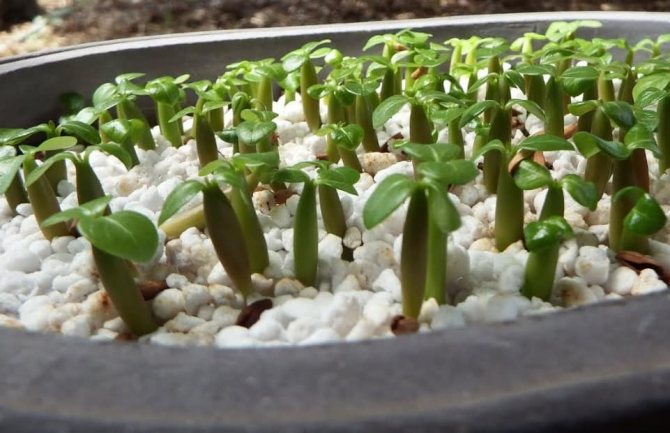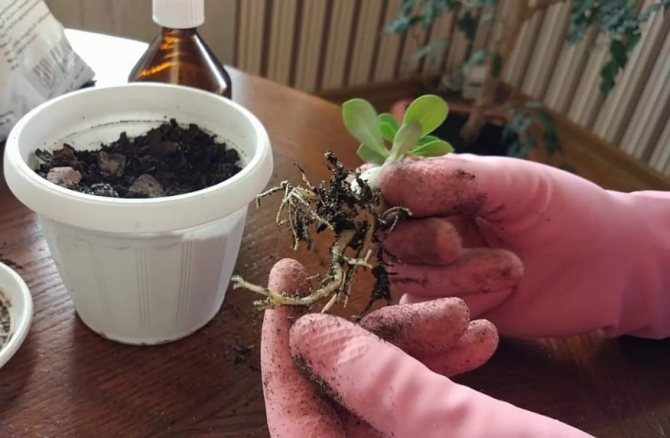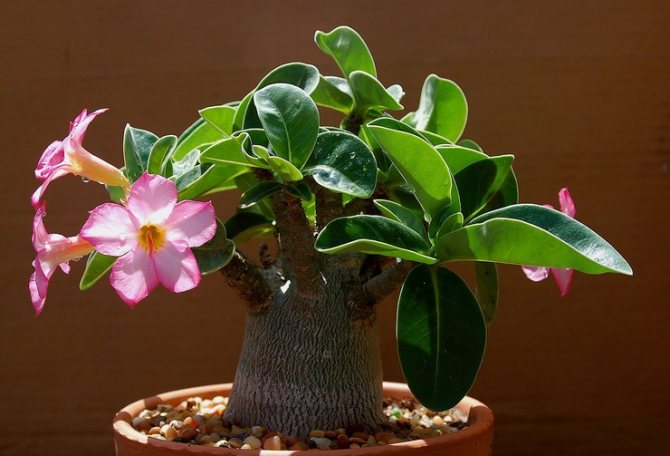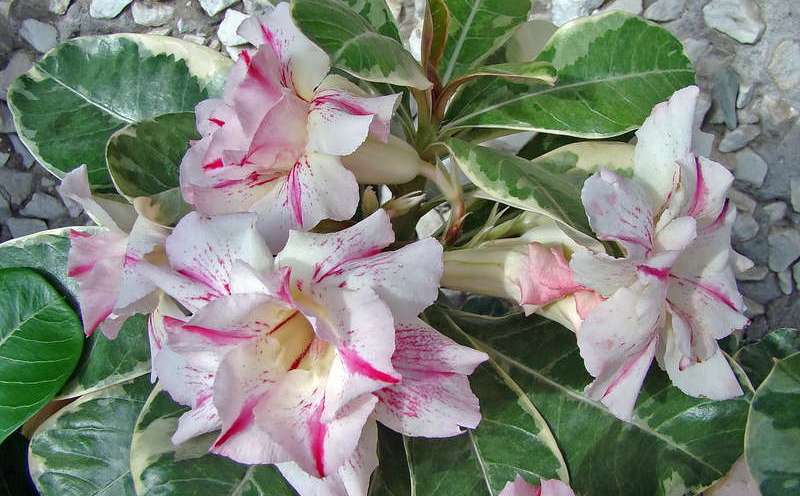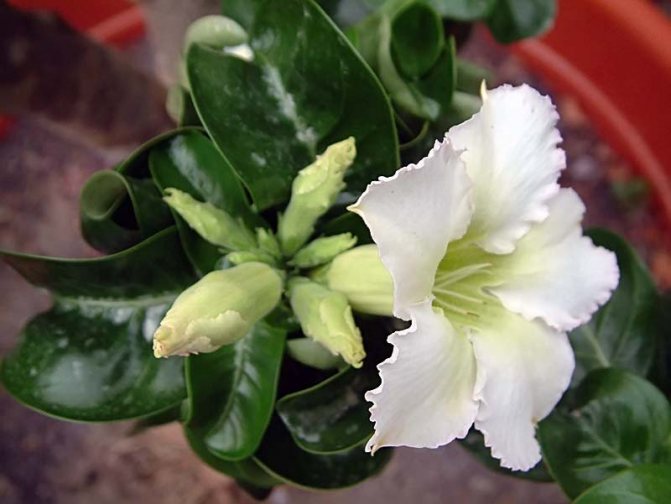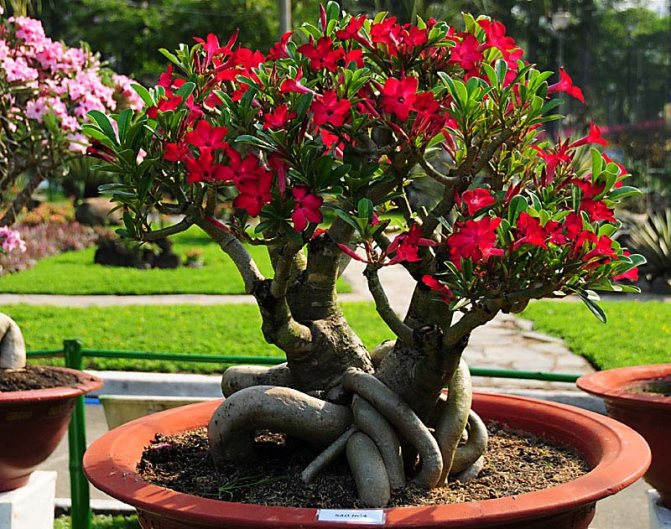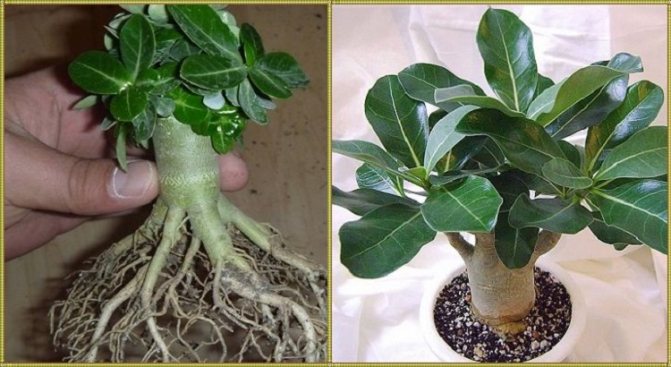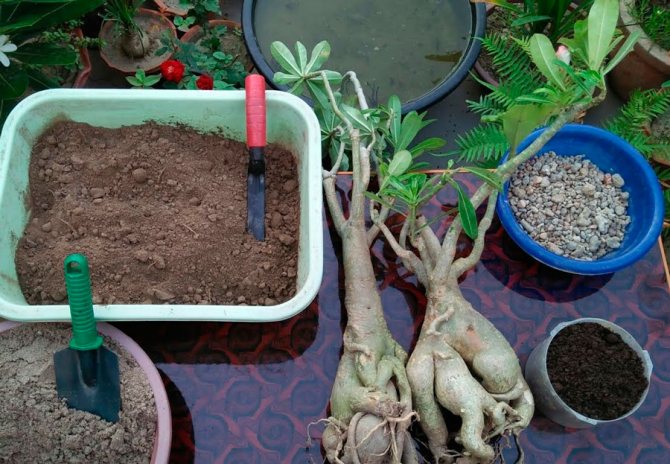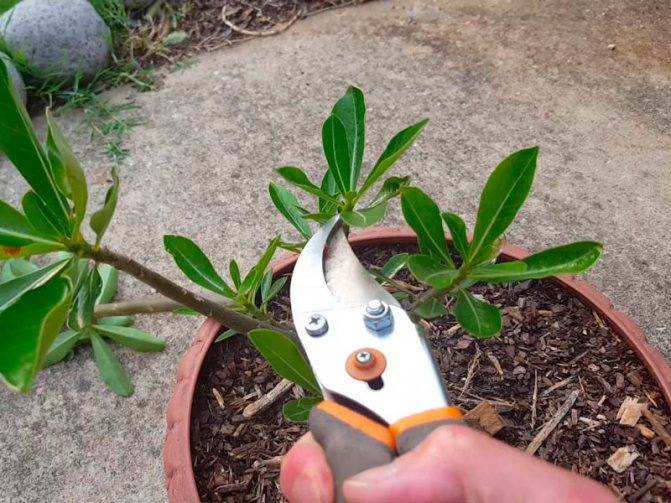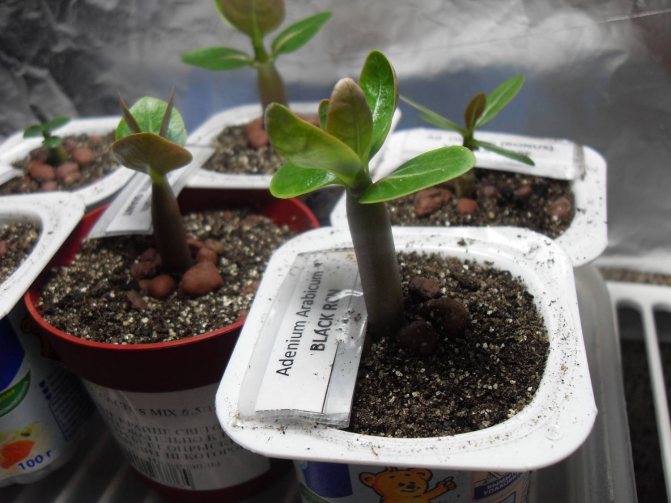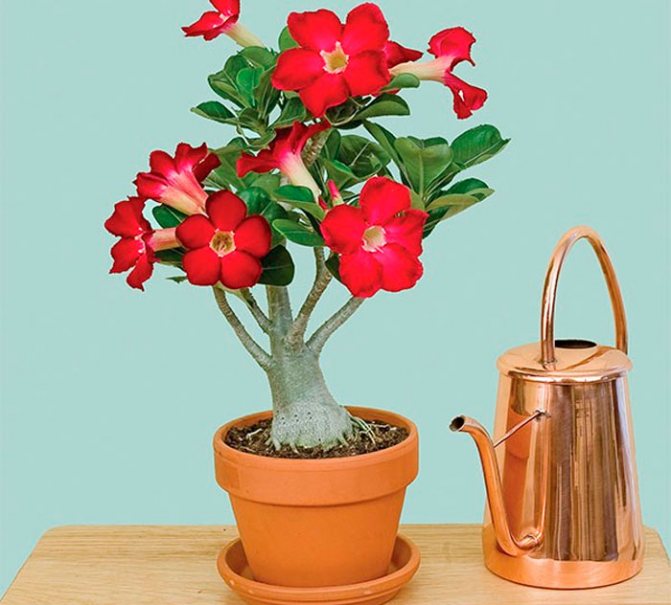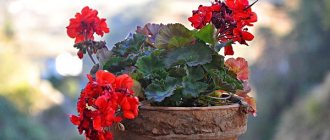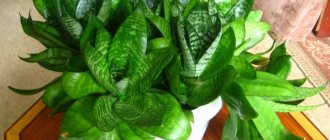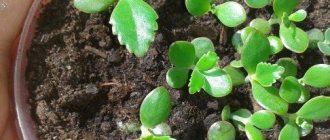The plant adenium (Adenium) is a member of the Kutrov family. This genus contains 5 species. This succulent is found naturally in Central and South Africa. In indoor conditions, such small trees or shrubs reach a height of about 0.35 m. The trunk of this flower is thick. The surface of glossy sheet plates is velvety. Quite large flowers are painted white or dark crimson. Such a plant has many other names among the people, the most popular is "Desert Rose", because this flower has a resemblance to a rose.
Description
The shape of the flowers is funnel-shaped. Depending on the Adenium variety, the inflorescences can consist of a different number of flowers, their color: red, white, cold or warm shades of pink. Forms with double flowers are known.
Sometimes a combination of two colors is observed: for example, petals painted in white or pink become crimson closer to the edge. A yellow center is often found in white or pink flowers, a white center in red flowers.
There are very beautiful varieties with a pattern in the form of stripes radiating from the center.
Leaves are solid, elongated, elliptical or pointed in shape, less often - somewhat widened towards the outer edge (teardrop-shaped). They can be located in bunches closer to the ends of the branches or alternately along the entire length of the branch.
Varieties of adeniums with photos and names
Adenium boehmianum

This species differs from the rest in the color of the flowers. In pinkish-lilac or bluish-white flowers, the pharynx and corolla tube are purple.
Adenium multiflorum
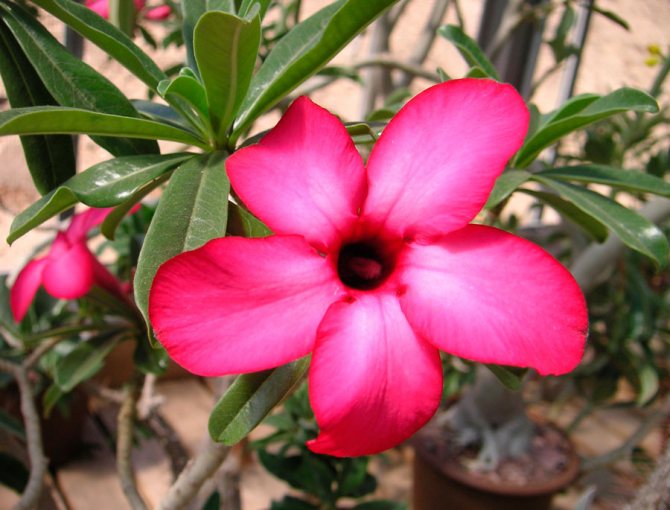

The height of the bush is about 2.5 meters. The trunk branching at the top becomes lignified over time. Flowers of this type are similar to the flowers of adenium obessum, but there are more of them.
Soil and its composition
In hot countries where Adenium is cultivated, the soil contains many elements typical of this area. For example, coconut fiber, rice husk, fragments of tree fern are added to the soil.
Despite the excellent results, this soil composition unsuitable for more northern latitudes.
In Russia and European countries, when preparing soil for Adenium, the composition represents more accessible components: peat, leafy soil, and some other additives.
The soil for Adenium should provide very good moisture and air permeability, be neutral or slightly acidic.
The mixture includes peat and leaf soil with the addition of river sand, a small amount of charcoal, small stones for better drainage.
Coconut fiber can be added if desired.
One of the options for the composition of the mixture: 50% coconut fiber + 25-30% deciduous-humus earth + river sand of small or medium fractions.
Which land is best for Adenium?
A good solution is to buy ready-made soil for succulents.
It is not recommended to add broken brick fragments or small expanded clay to the soil. Sharp edges will damage the roots of the plant.
If such foreign bodies get into a tight root weave, they will be impossible to remove from there during transplantation. These fragments interfere with the natural growth of the roots.
For the successful cultivation of Adenium, in the ground you can add any fungicidal agentto avoid fungal diseases (about growing adenium from seeds at home is described in this material). This measure will be most effective where summers are humid and cool. In other climates, it is quite simple observe the regime of the strait, do not overmoisten the plant.
Reproduction methods
Growing adenium from seeds
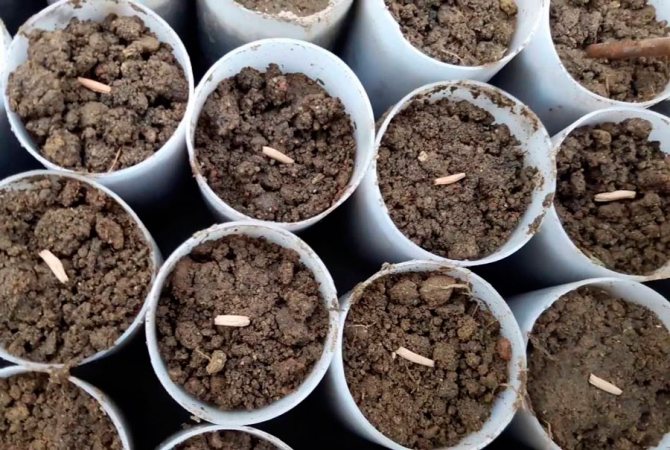

With prolonged storage, the seed material of adenium loses its germination capacity, in this regard, only fresh seeds should be used for sowing. They are sown in the last winter or first spring weeks.
The container is filled with a substrate consisting of charcoal, sand and vermiculite. The seeds need pre-sowing preparation, for this they are placed in a solution of potassium manganese for 30 minutes, and then they are kept in a lukewarm solution of Zircon for several hours. Seeds must be spread over the surface of the substrate, and then they are covered with a thin layer of soil mixture. The crops are placed in a warm place (from 33 to 35 degrees), seedlings will appear after a week. If the crops are in a cooler place, then the seedlings may appear later or this will not happen at all. When the plants appear, they will need to be illuminated with fluorescent lamps, they will also need to provide regular ventilation, while the air temperature in the room should be at least 18 degrees.
After the flower has formed the first two true leaf plates, they gradually begin to look after it like an adult specimen. And when 2 more leaf plates are formed, the seedlings should be cut into individual containers.
Cuttings


Reproduction by apical cuttings is a rather complicated process, since they can easily rot. Cuttings are carried out in the summer or in the spring. The cuttings must be divided into parts, the length of which should be about 12-15 centimeters, then they must be dried by treating the cuts with charcoal. In order for the cuttings to take root, it is necessary to use perlite, a mixture of sand and charcoal or small expanded clay. It is necessary to pour sand or small charcoal around the root collar, thanks to this, the base of the stem will not rot. Cuttings need bright sunlight, while the air temperature should never be below 25 degrees. Waterlogging of the soil should not be allowed. If everything is done correctly, the cuttings will take root after 4 or 5 weeks.
How to propagate by layering
In May and June, such a succulent can be propagated by air layers. Take a very sharp knife and use it to make a circular incision on the shoot (the stem should be 20 mm across). After the incision site dries up, it should be treated with a solution of a product that stimulates root growth. Wrap this place with sphagnum moss, which must be wrapped on top with opaque cellophane. Remember to keep the moss wet on a regular basis. After about 4 weeks, the roots should appear, then the layers are separated from the mother plant and planted in a container filled with a substrate intended for an adult bush.
Reproduction by grafting


To inoculate such a culture, you can use another adenium or Oleander. Make cuts in the scion and rootstock with a very sharp knife, then they are combined with each other, and then the plants are firmly held together (you can use a special spray). Make sure that the air temperature in the room is not less than 30 degrees, the air humidity should be high, and you will also need bright lighting. The new bush must be protected from direct sunlight, and the shoots that have appeared on the rootstock must be cut off immediately.
Shine
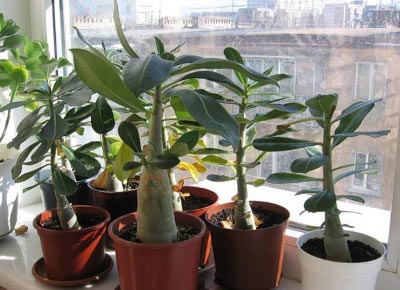

Adenium - very light-loving plant.
It is recommended to keep it on the lightest window sill, usually the south window.
In the height of summer, there is a danger of being burned by direct sunlight.
Light shading can provide either taller houseplants, or tulle, a curtain made of translucent fabric.
Planting and growing methods
In order for the adenium to have a thickened trunk, it is necessary to grow the plant from seeds, since it will be difficult to achieve this during grafting. Desert rose seeds quickly lose their germination, so when buying planting material, pay attention to the expiration date. Fresh seeds have a germination rate of 99% and there are no problems with their germination.
Florists believe that the end of February - the beginning of March is suitable for germinating seeds. For 3 spring months, the plant has time to take root and get stronger, entering the growing season. It is not necessary to soak the seeds before sowing. In a horizontal position, they are buried 0.5 cm into the moistened soil of a mini-greenhouse. Strong waterlogging of the soil is not necessary, every day the greenhouse is opened for 15–20 minutes. for airing. Seeds germinate in 4-7 days, but sometimes this process can be delayed for 2 or 3 weeks.


Seedlings of Adenium during germination have a characteristic bottle shape
After 2-3 months, when young specimens have several leaves, they are planted in a permanent place for further growth. Adenium will bloom after planting no earlier than in 1.5–2 years.
When a plant is propagated by cuttings, planting material can be purchased ready-made or obtained from an adult plant. Rooted cuttings flower much earlier than seed-grown specimens. Growing by cuttings allows you to preserve the plant's breeding properties without mutations. If you cut off the lower root part from the adenium, then the apex and roots will be viable and can grow on their own.


You can get planting material for propagation by cutting the root part
Sections of cuttings need to be dried and powdered with charcoal powder, as they quickly rot. In a container for planting near the cutting, clean river sand mixed with crushed charcoal is placed. Root survival occurs in 3-4 weeks at a temperature of + 25 °. The soil at this time is sprayed from the sprayer as it dries up.
Young adeniums are actively starting to grow and they need an annual transplant into a more spacious container. Saplings from seeds are transplanted once a quarter, increasing the volume of the planting capacity, and their counterparts, who have grown by cuttings, need a transplant only after a year. The pot should be chosen wide, since the root system of the adenium is powerful. If, during transplanting, each time a part of the root system is raised above the soil level, then over time it turns into a kind of ornate trunk.
To create favorable growth conditions, a drainage layer is placed at the bottom of the pot, and the soil is selected light, airy and hygroscopic. The reaction of the soil is allowed from neutral to slightly acidic. To obtain such characteristics, crushed vermiculite or perlite is added to the soil.
Temperature regime
The life of a plant is quite clearly divided into periods: wintering, or dormancy, and active growth. Adenium requires a gradual transition from one mode to another.
The optimum temperature in summer, in the warm season, is about 20˚С. It is necessary to take into account the climate of a particular area: temperature and humidity.
Maximum the temperature in summer is not more than 30˚С.
In winter, during dormancy the room temperature should be moderate: about 12˚– 15˚C.
Adult plants usually tolerate a nighttime temperature drop to + 5˚– 0˚С, provided that the air warms up to + 10˚С and higher during the day. However, it must be remembered that with such a decrease in temperature, the the risk of root rot.
What to do if the plant starts to wither after the procedure?
Violations of the rules for pruning and shaping can lead to plant disease, which begins to wither and eventually dies (for more information about diseases and pests, see here). First you need to find out what is the cause of the disease and take measures for treatment.
Adenium withers only if the procedure is carried out incorrectly and the room conditions are violated after pruning / shaping. Withering gradually leads to final death. However, it is still possible to restore the state of the plant.


- Watered often? - the root system will rot from waterlogging! The same situation will arise due to an unsuitable container or lack of air in a stuffy room. Rotting adenium is recognized only after it is possible to pull it out of the pot to check the roots. The damaged areas must be trimmed carefully and also carefully removed into the vessel.
- Are the branches withering? - this is normal, because after healing, the cut branches dry out, but if the dryness appears higher and higher, you need to remove the damaged tissue and treat the sections with antibiotics.
The beauty and exotic appearance of this plant is possible only with the utmost care, and then, perhaps, your adenium will conquer any flower exhibition.
If you find an error, please select a piece of text and press Ctrl + Enter.
Air humidity
Only young plants need regular spraying. For older Adeniums, spraying is necessary only in the hottest seasonif the natural air humidity is insufficient.
Freshly transplanted or grafted plants can be particularly sensitive to moisture. If it seems to you that the plant is suffering from a lack of moisture in the air, spray it gently.
The spray bottle must be in perfect working order, otherwise large falling drops may cause sunburn.
Flowering plants are sprayed from a considerable distance. Spray jet shouldn't be aimed at flowers - it is enough that a light fog appears in the air.
When is it recommended to trim
To obtain a decorative tree, it is advisable to prune no earlier than 1 year after rooting the cuttings or sowing seeds. The best time to prune is at the end of winter, when the plant wakes up after a dormant period.
In theory, pruning can be done at other times of the growing season, but branching as efficiently as in spring can hardly be expected. It is not recommended to start pruning in cloudy weather, which lasts several days in a row. It is easier to initiate the awakening of the lateral buds in bright diffused lighting, in extreme cases, after all the manipulations with the haircut, the plant is provided with artificial lighting.
Features of care after purchase
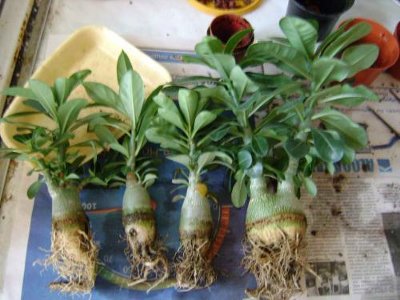

After purchasing a desert rose, caring for the plant will require some attention.
Not recommended transplant the plant immediately after purchase, you need to give it time to acclimatize.
On average, 7 to 15 days are enough for this. The exception is when you get worried when you find signs of illness.
If you buy an Adenium flower in the fall, it may shed its leaves after a short time.
This is a natural process - preparation for winter, Adenium enters a period of rest. You watering should be reduced and provide a cooler room temperature.
If you have little experience in breeding succulents, it is better to immediately invite a specialist. An experienced florist will notice the signs of the disease in time, determine the treatment, and you will need to follow his recommendations.
Diseases and pests of Adenium, characteristic of them in tropical conditions, are rarely found in northern latitudes (why do the tips of leaves turn yellow and dry in adenium and what are the causes of diseases read here). The most serious danger remains the decay of the caudex, which occurs due to excessive watering at medium and low temperatures.
Diseases and pests of adenium
Yellowing and flying around foliage


Adenium can begin to lose foliage due to the fact that the room is very cold, or it was placed in unusual conditions, and it can also happen due to a draft. To save a flower, you need to start taking proper care of it.
Falling foliage in autumn is considered quite normal, as the plant prepares for a dormant period.
Harmful insects
Such a culture is highly resistant to pests. But in some cases, ticks, scale insects and mealybugs can settle on the bush.
Trimming and shaping roots (caudex)
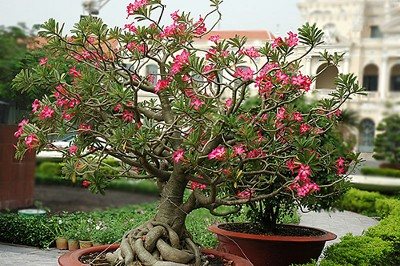

How to form Adenium at home?
Crown formation is not always a 100% predictable process, but with some patience, you can get the Adenium of the silhouette you planned in advance.
Young shoots pinch, more adults and wide - crop.
The wider the stem diameter and, accordingly, the larger the cut area, the more new shoots will appear around the circumference.
Sometimes some of them dry up or stop developing. More often they are corrected, unnecessary ones are removed. Usually two or three young shoots are left symmetrical.
Heavy branching is expected approximately 50 (plus or minus 5) days after pruning. How to trim adenium?
When pruning Adenium at home, correct height above ground level - a necessary condition for the harmonious development of the plant.
It is generally accepted that the minimum height is 10 - 11 cm. If the pruning is too low, many thin shoots are likely to appear. In this case, an adult plant will appear disproportionate.
For old plantsIf the shoots are very elongated or where there are relatively few flowers and leaves, pruning is a way of rejuvenation.
The best time to trim is the beginning of intensive growth.
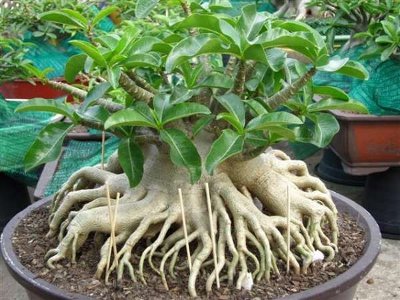

Adult decorative adeniums often surprise with complex interweaving of roots.
A special art is the creation of a kind of sculpture based on the caudex.
Bulk Adenium Root can turn into the body of a dragon, another animal or a fabulous bird with a tuft of living leaves and flowers.
Other Adeniums attract attention with their caudex with numerous weaves, beautiful embossed patterns and knots (read about what to do if the caudex has shrunk, withers and becomes soft, read here).
How to form a caudex? To achieve this or a similar effect, caudex formation is performed, when the plant reaches age. One of the popular systems is called the "octopus". A young plant, which has just begun to form a root system, is planted in the ground on a special disk. Thanks to this solution, the roots grow to the sides, and not down.
The number of main roots of the "octopus" varies: from 3 or 4 and more. The excess processes are removed... The growing roots are carefully fixed in the desired position; for this, wooden sticks, matches, toothpicks are used.
They are easy to remove or move when the need arises.
It takes a lot of time and patience to create an unusual sculpture from the roots of Adenium, but the result is truly amazing.
Possible flower problems
In winter, the leaves often turn yellow and fly around, but in the spring they grow back and restore their decorative effect. If the flower branches little and seems ugly, pinch the apical shoot.
Of the diseases that affect an indoor flower, root rot is most common - the result of improper watering, waterlogging of the earth. Possible pests are spider mites, mealy worms. For treatment, folk remedies or purchased drugs are used.


How to plant adenium at home
Very often, vaccinations are used to reproduce adeniums. It looks especially beautiful when several varieties are grafted onto one tree. Different types of inoculations are used: "in a split", in a lateral incision, V-shaped inoculation, eye inoculation, flat inoculation.


Several varieties of adenium with different flower colors can be grafted onto one plant.
Most often, the stock is a young adenium grown from seeds, and the scion is a stalk of a hybrid.
Cleavage grafting
The cleft grafting is the easiest way to breed. Due to the fact that the area of contact between the scion and the rootstock is large enough, the survival rate of cuttings is very high. It is also the best way to graft a dormant adenium stalk. However, it is not always possible to obtain an aesthetically perfect result in this way. Often the vaccine looks sloppy.
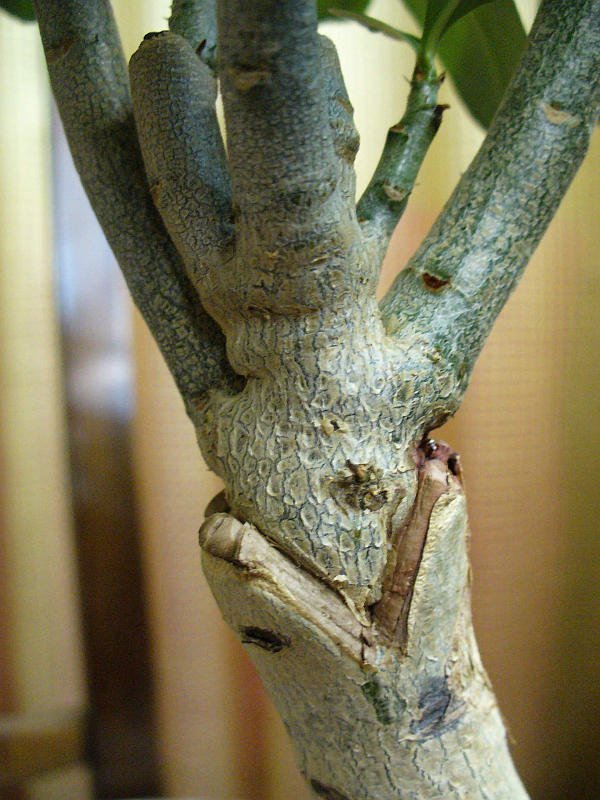

Unsuccessful split grafting leaves unsightly transitions between rootstock and scion
Stages of cleavage vaccination
- We cut off the upper part from the rootstock, leaving a stump of 7-10 cm. We cut the cut in one motion.
- For the scion, we take a freshly cut cutting from 4 to 12 cm in length and the same thickness or slightly less than the grafting site.
- Cut the lower part of the scion with a wedge with two sides.
- We make a cut in the center of the stock.
- Insert the scion wedge into the cut.
- Wrap with plastic wrap for better adhesion. You can use fum. tape or adhesive tape with glue up.
- We put on a transparent bag for the vaccination and tie it tightly so that there is a humid microclimate inside the vaccine bag.
- We leave for 2 weeks in partial shade.


Scheme of grafting into cleavage - the most common way of reproduction of adenium
To form a lush crown in adeniums, the best option would be to use a lateral incision grafting, this is one of the varieties of cleft grafting. In this case, an incision is made on the stock on the side of the central trunk, into which the scion is inserted.
Inoculation of adenium in the lateral incision
V-grafting is also an option for cleft grafting. It is advisable to use it if the stock is much thicker than the scion. With further overgrowing of the wound, a very beautiful transition is obtained.
When carrying out a V-shaped grafting, the actions are the same as when grafting into a split, but not an incision is made on the rootstock, but a wedge-shaped notch, so that the cutting will enter more tightly.
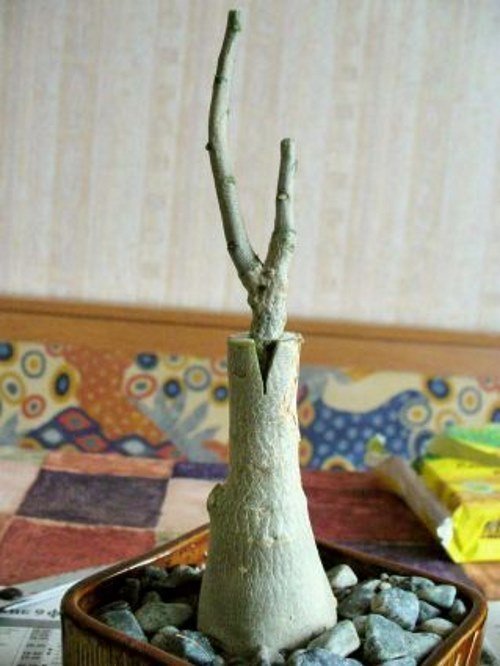

V-grafting is applied on thick rootstock
Peep-shot is also a form of cleft inoculation. But in this case, only 1 kidney serves as a scion. It is used when there is a lack of grafts.
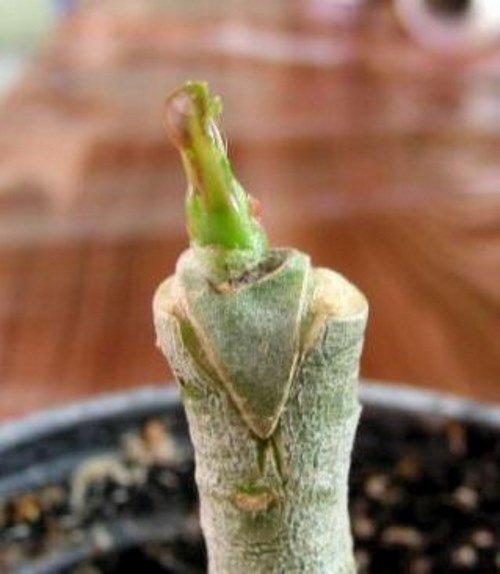

Peephole grafting is used when there is a lack of grafts
Flat vaccination
Flat grafting is radically different from those described above. At the same time, she is the most beautiful, extremely simple and very successful. The main conditions for this vaccination are the active growth of the rootstock and the speed of your actions. Vaccinations on adeniums do not require the alignment of cambial layers, which further simplifies the process.
The grafting can be carried out on any plants with a diameter of more than 8–10 mm at the cut point. The cut both on the rootstock and on the scion should be as even as possible, it should be done with a sharp and clean knife or, even better, with a blade. The scion diameter must be less than or equal to the rootstock diameter. The graft can be of any length, the main thing is that there is at least one dormant bud, you can use the cut off top of the adenium.
The vaccination technique is very simple:
- Cut the stock with a razor in the desired place for grafting.
- Cut off the stem for the scion, which should have one or more dormant buds. Leaves, if they are on the handle, must be removed.
- Place the scion stalk on the stock, fix them firmly to each other with plastic tape. It is ideal to use a narrow stretch film for this purpose.
- To improve the conditions for the growth of the scion and rootstock, the graft is placed in a transparent plastic bag. The package can be removed when the first signs of a successful operation appear - awakened buds or new leaves on existing shoots should appear on the scion.


Flat grafting gives good results
Video: the best method is flat grafting
Top dressing and soil
When growing adenium, one must not forget about feeding. Fertilizers are used in spring and during flowering. Specialty stores sell special mixtures for succulents and cacti, they should be rich in potassium and phosphorus.
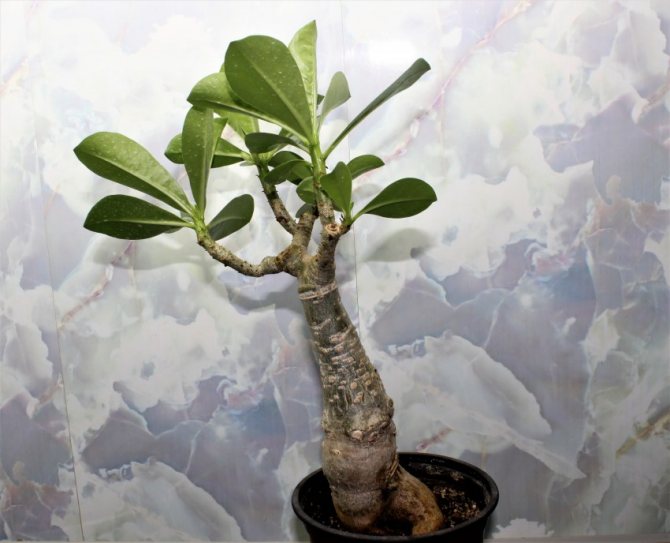

The soil is chosen loose, since the roots love air. To prevent water from stagnating in the soil, add foam or brick chips, we also need good drainage. Flower shops sell a special earthy mix for succulents.
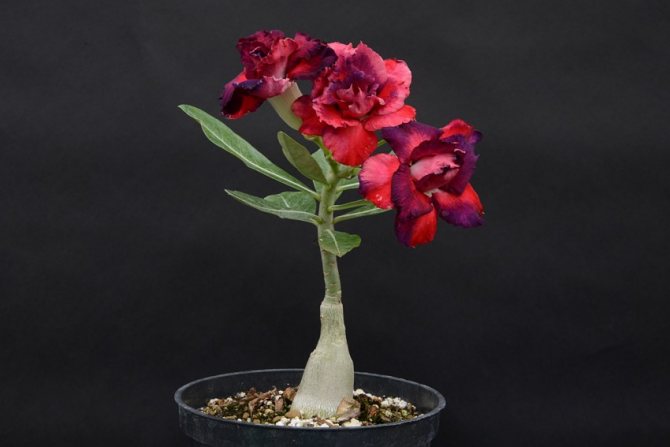

A little about the nature of species adeniums
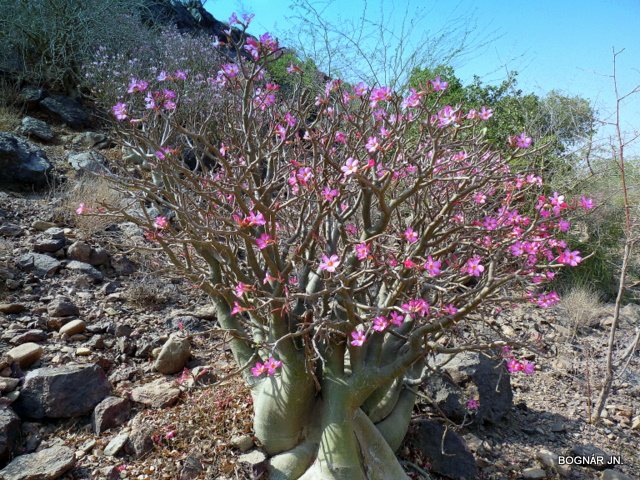

In the wild, adenium species grow according to the type of apical dominance - this is when only one main shoot is active in a plant. Although the lateral branches are laid at an early age, they begin to grow many years later, when the desert rose looks far from aesthetically pleasing.
For this reason, pruning arabicums and tai-sokotranums rarely produces good results. A lot of buds can wake up, but the plant will give strength only to the fastest and most powerful shoot. You will receive a maximum of two replacement branches - a "slingshot" instead of a "fishing rod".
A few tips from experienced florists
- In order for the plant to develop evenly, it is periodically turned in different directions relative to the light source. If this is not done in time, the desert rose can grow lopsided or with a curved crown.
- When sending a plant to a cool room for the winter, check the humidity level in it. With high humidity, the chance that the plant will be susceptible to a fungal disease is great. Cool air is safe for adenium only in dry rooms.
- Adult plants do not need to be transplanted frequently; it is enough to do this once every 3 years. After transplanting, do not moisten the soil. Wait until the ground dries out - this will allow the roots to take root better.
Adenium attracts with its exotic uniqueness. Watching its gradual development is an exciting experience. The desert rose is viable, it responds to care with the beauty of abundant flowering. Such a copy of a house plant will be appropriate in any interior, decorating it with its presence.
Crown formation rules
To obtain branching and to ensure intensive formation of lateral buds, the crown-forming procedure is carried out several times. Without its implementation, the plant after a while is pulled into a long stick.
When the seedlings are three weeks old, pinching is recommended. At the same time, the top of each flower is removed. After that, the branches are shortened every two years.
There are a number of rules for forming a crown that you need to adhere to:
- the shoot is cut at two-thirds of the height. If the plant is subjected to such manipulations for the first time, then the stem in height should be left within 5-9 centimeters;
- all weak shoots are removed. If this is not done, they will still dry out. Their timely cutting leads to the active growth of new branches;
- branches growing inside the crown should not be left on the flower;
- the number of shoots of the second, third order must be increased exponentially;
- when thinning an adult flower, the cuts are made at the dormant bud facing outward. Five millimeters are measured from it and the entire upper part is cut off.
Conclusions from the experiment
- In practice, we have made sure that by cutting the leaves it is possible to achieve excellent branching in species adeniums.
- The main condition is that your seedlings should have awakened lateral buds. Without this, cutting the leaves is useless. But even their presence does not always guarantee an excellent result. Therefore, it is not worth rushing with "fashionable hairstyles".
- Not the fact that you will immediately achieve the desired effect. But the formation of adenium is a laborious process. You can try again, so that the stubborn will branch out.
- But don't get carried away with the method. Plant leaves play a very important role in the processes of nutrition and respiration.Cutting them off constantly can cause growth inhibition. Everything is good in moderation.
- The first pruning is best done after a pick, so that neighboring seedlings do not obscure each other.
- At a young age, it is worth taking a break of one or two weeks between transplant and haircut.
- As we wrote above, species adeniums are very demanding on lighting. Without a lot of light, any experiments with them will be doomed to failure. So make sure you have plenty of sun on your windows and that your lights are powerful.


Reviews about growing indoor flower
Easy to grow from seed. Not whimsical at all, requires moderate watering. In no case do not flood or overdry the soil. It blooms almost constantly in the warm season. The flowers are big and just a sight for sore eyes. Resting in winter. Its trunk is tree-like, giving the plant an original look in the bonsai style. Decorates my interior and pleases the eye, cheers up in bad weather.
wave
My adeniums are not blooming yet. The oldest bought Adeshka is six months old (sowing June 2015), this is a mini, but I can count on flowering only next summer. And then, if Adeshka is pleased with my departure. Varietal traits through seeds are poorly transmitted, so anything can grow. Because of this, it is even more interesting to grow fry.
shooik
I have been studying adeniums for about 4 years, although I knew about them much earlier. In the early 90s, catalogs for cactus growers began to offer seeds of adeniums, but then the sowing results were zero. This was due to the lack of experience and the only known address of the supplier. And I suspect the seeds were old then. Now the situation has changed much for the better and several varieties of adenium are growing in my collection. At home, they grow slowly, blooming only in the third or fourth year from the date of sowing. In greenhouses, flowering is possible in the first year, and be healthy!
ardney
How to form caudex
The formation of adenium caudex can be started in young seedlings. It will be possible to grow an unusual flower if you combine several varieties of a plant with each other. This procedure is performed according to the following scheme:
- The seedlings are interconnected and wrapped with foil.
- In the next step, the plants are placed in soil.
- The film is changed periodically.
- After a couple of months, the bandage is removed.
- At the points of contact of the trunks, cuts are made and the succulents are again connected.
- The bandage is applied for one month. During this period, the trunks will have time to grow together and build up a powerful root system.
Trimming of the roots is also done, it also helps to form the caudex. The most original version is in the shape of an octopus. This removes not only the central root, but everything that goes down and narrows. You can also not prune them, but simply systematically raise the flower above the ground, thereby achieving a gradual exposure of the root system.
For the first time, root trimming is performed at the age of about three months. At the same time, an intensive increase in the volume of lateral roots is noted. With their gradual rise, a lush and very original caudex is formed.
There are certain rules according to which the formation in the shape of an octopus is made:
- In a strong seedling, the central root is shortened, as well as the roots growing downward.
- Soil is poured into a pot of soil with a slide, and a circle made of plastic is placed on it.
- A flower is placed directly on the plastic.
- The lateral roots are straightened and fixed in this position with a wire. The use of plastic sticks or small stones is also allowed.
- At the very base of the succulent, a large stone is placed, giving the root system an unusual shape.
- From above, the roots, which have been straightened, are sprinkled with earth.
- The plant is fixed. He is tied to a support.
- At the next transplant, the adenium rises slightly a short distance.Rapid lifting of the roots can lead to the development of the disease.
Adenium transplant
In nature, adenium is a powerful plant with a large root. Therefore, you need to limit its growth to the size of the pot.
If you want a small, branchy plant, plant it in a low, wide pot so that the roots grow in breadth. If your variety grows mostly upward, then choose a narrower, deep container.
Young plants need to be replanted every 2-3 years. They are usually transplanted in the spring, until active growth begins. Do not water it the week before this event. After transplanting, watering is also not needed immediately - the damaged roots should dry out. Sometimes flowers are planted 2 cm higher than in the previous pot, so that an unusual trunk is formed and some of the roots are visible above the soil.
General characteristics
Adenium also has other popular names:
| Desert Rose; | Star of Sabinia; | Impala lily. |
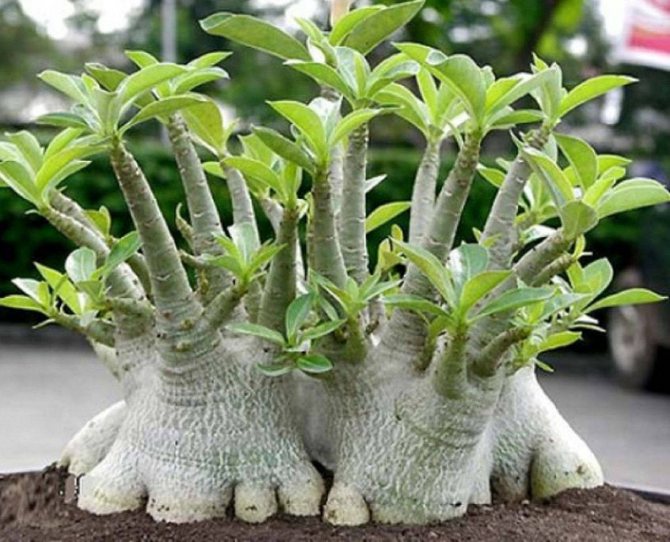

Until recently, this succulent was unknown in our country, but now it has become quite popular, especially since there is no need for special attention from the grower, since caring for adenium at home is quite simple and does not require specific skills or skill.


For reference!
Now about 50 varieties of succulents are known, which in their natural habitat can reach several meters in height. But, at home, obese adenium is often grown, which has a certain outward resemblance to bonsai.
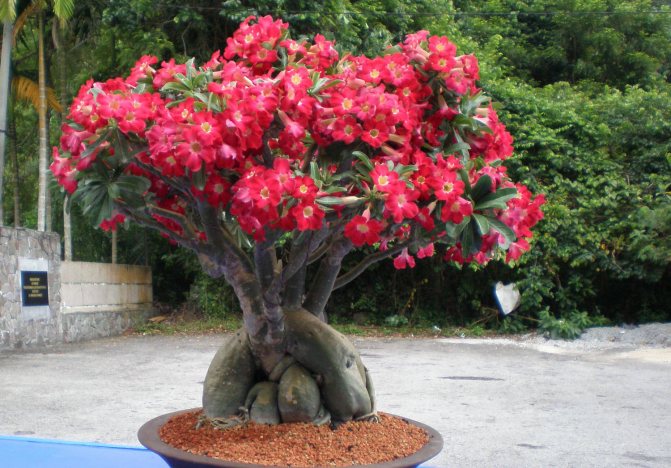

Popular varieties
Botanists still cannot come to a consensus on how many species of Adenium exist in nature. There are ten main species, depending on the shape of the caudex, leaves, and habitat. Although other scientists are of the opinion that all species diversity comes from the main species - Adenium Obessum.
The development of desert rose breeding occurs mainly in the countries of Southeast Asia: Thailand, the Philippines and others. This is because the climate is suitable for growing Adeniums. In these countries, many new varieties of indoor desert rose have been bred.
Obesum
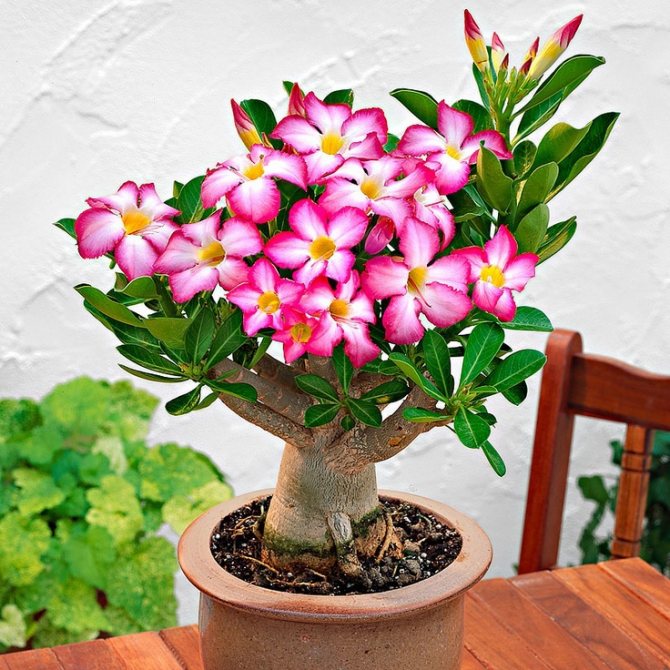

Adenium Obesum
Among florists, the most widespread variety is Adenium Obesum. Its second name is Adenium Fat or Fat. Under natural conditions, the aerial part of the caudex grows up to a meter thick, and the plant reaches a height of up to three meters. Green leaves are found in an oblong, rounded shape, with pointed ends. There are varieties in nature with variegated leaves, glossy or dull.
The flowers of Adenium Obesumi are large, 5-7 centimeters in diameter. Breeding varieties are distinguished by a variety of colors: from snow-white to dark red, burgundy flowers.
The plant begins to bloom at the age of one and a half to two years, but much depends on the growing conditions. The flowering period is at least two to three months. With a suitable temperature regime, Adenium pleases with long flowering.
Arabikum (Arabicum or Arabic)
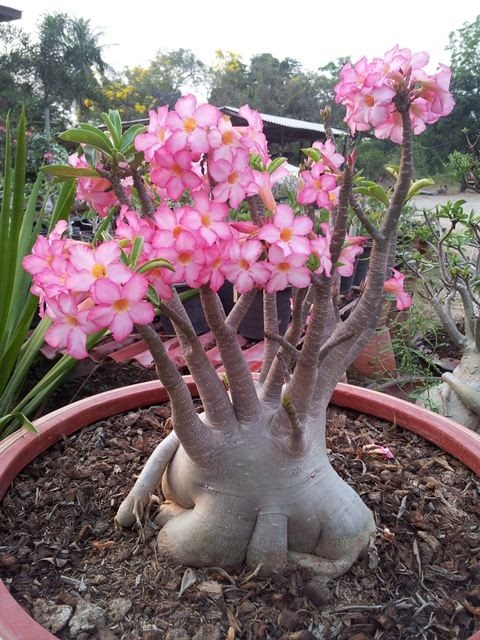

Adenium Arabicum (Arabic)
This variety differs from other Adeniums in large leaves, dark brown bark. Flowers at Adenium Arabicum are red-pink in color. The plant got its name from the place of growth in nature - the Arabian Peninsula. Caudex has a massive, squat appearance. Depending on the habitat, the appearance of the trunk can vary: from a thick tree to the shape of a shrub in places with a minimum of moisture.
Multiflora (Multiflora)
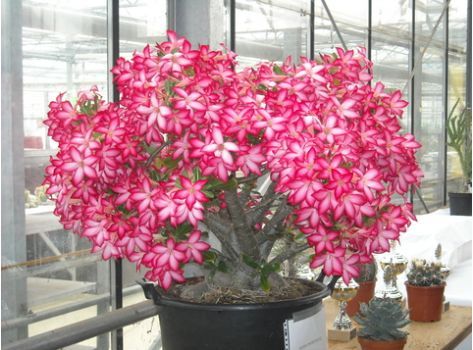

Adenium Multiflorum (Multiflorum)
The name of the Multiflorous Adenium speaks for itself. This species is distinguished by abundant flowering, grows in the central and southern regions of the African continent on saline or sandy soil. The thick trunk, widening downward, extends deep into the powerful roots. He is not afraid of droughts, because the powerful trunk serves as a repository of water supplies. The plant can reach a height of three meters in natural conditions.
This might be interesting: Aloe is the green doctor
This Adenium variety is also called Impala Lily. In indoor floriculture, the plant is less common than Adenium thick, due to its slow growth, and as a result, flowering occurs after four years.
Mini
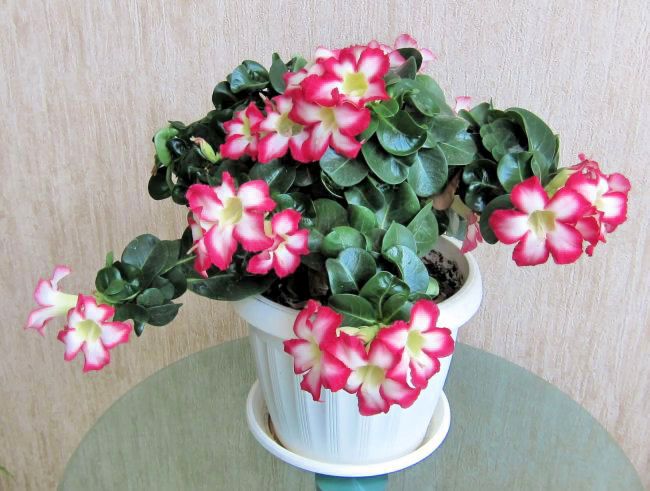

Adenium Mini
About ten years ago, breeders from Taiwan received mini Adeniums. These dwarf trees are similar to bonsai and decorate the interior by themselves. They are characterized by slow growth, and in 4-5 years they reach twenty centimeters. Intense flowering begins from two to three years and lasts throughout the year, unlike other varieties. The size of the flowers is quite large for dwarf plants, reaching seven centimeters in diameter. Varieties of Adenium mini differ in the color of the buds - from white to bright red.
Dorset Horn


Adenium Dorset Horn
As a result of the mutation of Adenium Multiflorum, a new variety Adenium appeared «Dorset Horn. " The leaves of the new variety curl, curving downward, and resemble the horns of the sheep of the breed «Dorset Horn. " In addition to the swirling leaves, «Dorset Horn ”shorter internodes of branches.
A feature of this variety is the instability of traits during reproduction. If grafted «Dorset Horn "to another Adenium, the leaves become even, the branches lengthen due to the increase in internodes. Therefore, this variety propagates only by cuttings or aerial rooting. Although even with this method, the characteristics of the variety are not always fully preserved.
Anouk


Adenium Anouk
The Anuk variety is distinguished by thick, fleshy leaves with a slightly elongated shape. The plant grows up to half a meter. The variety is distinguished by early flowering with a large number of bright pink flowers.
Solving the problem from collectors from Thailand
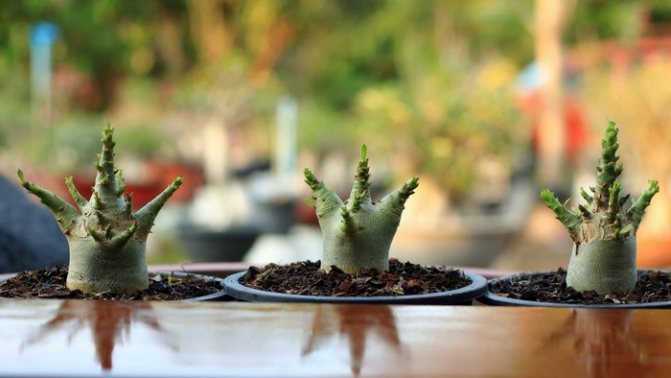

Breeding adeniums certainly helped to get well-branched hybrids. But without human intervention, even they will not have ideal forms. To do this, we need to deceive the natural mechanism, which is more than one hundred years old.
Therefore, collectors from Thailand came up with the idea of cutting the leaves on the main shoot in order to slow down its growth and activate lateral branching.
Species adeniums are very demanding on lighting. The plant considers the one that receives the most light as the dominant shoot. Even light shading with its own leaves can slow down the growth of the lateral bud. When we prune interfering leaves, all branches receive the same amount of light, which means that the adenium takes them all for the main shoot. It sounds simple, but there are nuances that you should understand before shredding your seedlings.
Virulence
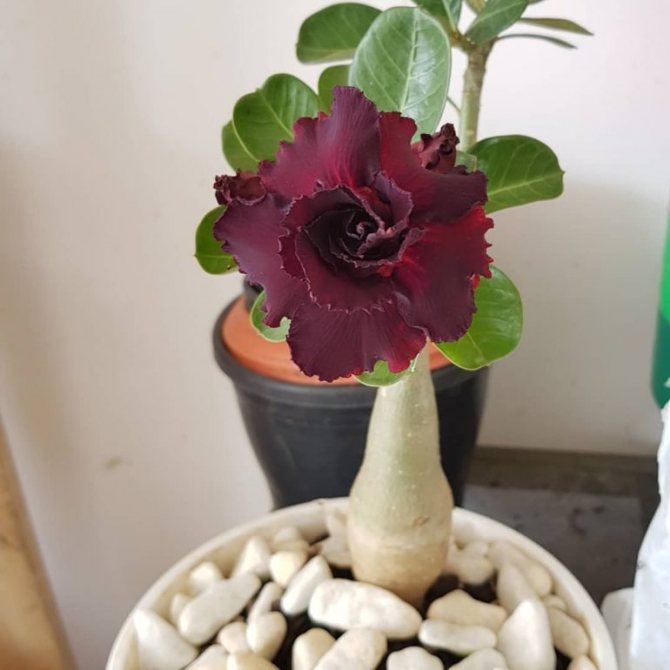

Photo of adenium in a pot
All parts of the plant contain poisonous sap, so extra care is required when in contact with it. All work is carried out with gloves, because the juice causes severe allergies. The tree should be out of reach of children and animals. In the homeland of the flower, warlike tribes still use toxic sap to make poison arrows.
Home care for adenium
In indoor conditions, a bottle tree grows up to 50-60 cm, and even a novice florist can take care of it. Since an exotic plant is warm and light-requiring, the agricultural technology of its cultivation has some peculiarities.
Adenium is one of those plants that grows in the open rays of the sun and does not require shading, so it is placed in the house on the windows facing the south. If the bottle tree does not have enough lighting, it will go into dormancy mode, and during this time its growth will stop. Adenium should receive sunlight for at least 12 hours per day. In the case when the flower has been in the shade for some time, it cannot be sharply exposed to the sun - the foliage will receive serious burns. It is necessary to accustom the plant to bright light gradually, for 1 hour a day, increasing the time spent in the sun.
The succulent tolerates heat easily; the range from +23 to + 30 ° C and above is considered a comfortable temperature for it. If the thermometer drops to + 10 ° C, the roots of the flower will begin to freeze and the plant may die within 3-4 weeks.
Adenium does not need spraying and normally tolerates dry air. The humidity level is permissible up to 70%; at higher rates, the roots of the flower will begin to rot.
How to care during growth and flowering: watering, fertilizing, pruning
For irrigation, settled warm water is used, it is necessary to irrigate an earthen lump only when it dries up. Do not forget that the inhabitants of the desert easily tolerate drought and do not like excessive soil moisture. Watering is performed in the morning or evening, when the sun's rays are not so active that the plant gets burned during the procedure.
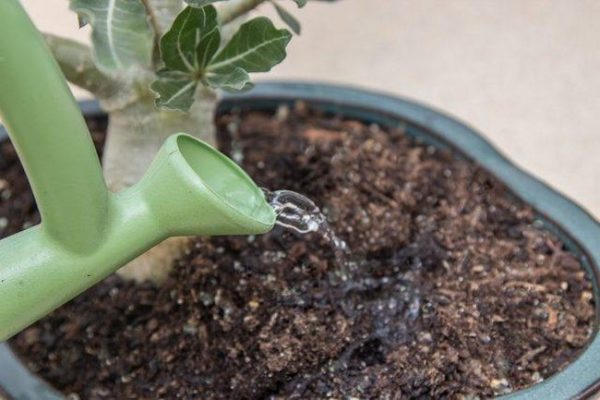

Watering Adenium is necessary after the earthen lump in the pot dries up
Adenium needs feeding from the beginning of awakening after winter rest. Fertilizers are applied in spring and summer. For these purposes, you can use ready-made complex formulations designed for succulents. If you want to make the formula yourself, you need to take equal parts of phosphorus, potassium and nitrogen. You can feed the plant 2 times a month, and from the moment the flower buds appear, the frequency of fertilizing is increased. At the beginning of August, fertilization is stopped, as the flower begins to gradually prepare for winter rest.
To stimulate the branching of the crown and create a decorative look, the adenium is regularly pinched and pruned. These procedures should be carried out in compliance with the rules:
- pruning and pinching is done only during the growing season;
- 2-3 days before the procedure, the plant is not watered so that its branches are elastic;
- trimming is performed with a knife or pruner to obtain an even cut;
- the cut line should be 2-3 mm above the level of the dormant kidney;
- before each cut, the blade of a knife or pruner is wiped with alcohol;
- the protruding juice is blotted with a napkin;
- pinching and cutting are done not lower than the first pair of leaves, not counting the cotyledonous leaves.
Any cut from a plant is afraid of water, since the tissues of the bottle tree are prone to decay. Sections are first dried in the open air, and then covered with garden mastic or powdered with charcoal powder.
Caring for the plant after flowering
In autumn, when the air becomes cool and the length of daylight hours decreases, the plant's development process slows down. Withered flowers are removed, feeding at this time is no longer carried out, and watering is reduced. Over the summer period, the roots of adenium filled the entire pot and waterlogging of the soil in combination with cold air can cause them to rot.
For wintering, a desert rose is transferred to a glazed balcony or to any other room where there are no cold drafts, and the air temperature will be from +12 to + 15 ° C. During the dormant period, adenium does not require attention to itself, it is possible to irrigate the soil at this time only if it is very dry. In this mode, the succulent lives until spring. At the moment of awakening of the buds, the flower pot is transferred to its original place.
Diseases and problems of flower care
If you follow the measures to protect the cuts when pruning the plant and prevent decay of the trunk and roots, observing the temperature regime and the frequency of watering, then other diseases of adenium are not terrible. But there is another danger - an invasion of insect pests.
When you notice that adenium flowers wither, leaves fall, a grayish-white bloom appears on the soil, thin stripes cover the trunk of the plant, or a spider web appears on the leaves and shoots - this means that your green pet needs urgent help.
Succulents are often affected by the mealybug, which loves to live in dry warm soil and damages the root system of the plant by feeding on its juice.It can be difficult to notice this pest in a timely manner, it reveals itself even when the plant has been seriously damaged.
Adenium can be attacked by other pests: aphids, thrips or spider mites. A small green aphid selects the inner side of young leaves and feeds on their juices. Outwardly, the leaves look eaten, with small holes or spots.
Thrips are small insects with wings that have a piercing-sucking apparatus, with the help of which they drink juices from the leaves of the plant. It is not difficult to spot thrips - you will notice a flock of midges above the flower.
The spider mite is also a dangerous plant-based pest. It can be detected by the presence on the shoots and leaves of a dense white-gray web with small insects around the lesion.
You can save a plant only if you treat it with an insecticidal preparation in time: Confidor, Intavir, Fitoverm or their analogues. As a preventive measure, it is recommended to treat the soil with insect pests once every six months.


